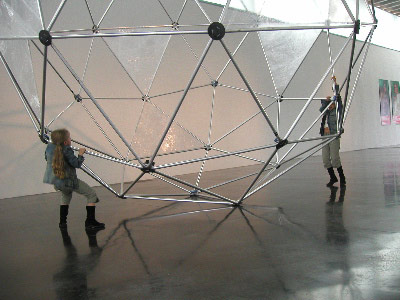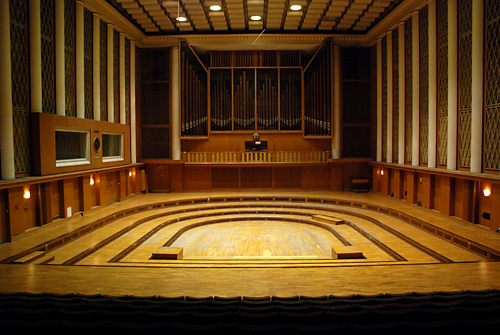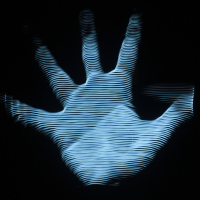2008
Posted in Text on January 3rd, 2009 by adminCurrent location =

Mooste, Estonia (photo: Pippa Buchanan)
Warning: obligatory year-end music post follows…
I decided to concentrate only on zero-eight releases, rather than catalog the expanse of my music vision quests of the last year. Some notes for future ethnographers:
Asva – What You Don’t Know Is Frontier [2008 Southern]
Morricone-style doom, moving through motions and moods. Excited to see them at Club Transmediale 2009!
Birchville Cat Motel – Four Freckle Constellation [2008 Conspiracy]
What could be one of the (many) final BCM records as Campbell Kneale seeks self-renewal through a name change. A standout release on a standout label from one man who probably releases every minute he has ever committed to tape at some point or another…
BJ Nilsen & Stilluppsteypa – Passing Out [2008 Helen Scarsdale]
Third in a trilogy of dark drone drinking songs, guaranteed to put me to sleep every time I play it.
Burial Hex – Initiations [2008 Aurora Borealis]
Glad to have discovered this creepy drone project for the End Tymes this past year.
Coffins – Buried Death [2008 20 Buck Spin]
No surprises here, just sick Japanese doom the way I like it.
Daniel Menche – Body Melt [2008 Important]
Daniel Menche – Glass Forest [2008 Important]
A pair of releases for Important records, one vinyl and one CD. Menche seems to have reneged on his promise to produce only vinyl or DVD releases, but both of these stand loud and proud in their own right regardless of the media they reach you in.
Dystopia – Dystopia [2008 Life Is Abuse]
A few short, somewhat lackluster tracks and a very long and boring cut up of schizo voices still teleports me back to the crust haven of Oakland California in the mid 90’s. Perhaps a swansong which didn’t really need releasing so long after the fact, but it did get me digging out their first couple of absolutely powerful records again.
Earth – The Bees Made Honey In The Lion’s Skull [2008 Southern Lord]
This is what happens when doom goes country.
Ghast & Yoga – Split [2008 Choking Harzard]
Ghast is screeching sandpaper on the vocal chords, heavy doom like a barbell dropped on your foot, while Yoga is odd, almost psychedelic sounding horror soundtracks. Look this one up.
GHQ – Everywhere At Once [2008 Threelobed]
Spacey American-style psychedelic folk-drone-rock whatever featuring Marcia Basset from Hototogisu/Double Leopards.
Grails – Doomsdayer’s Holiday [2008 Temporary Residence]
Further installment of Middle Eastern riff-rock from these Portland ambassadors.
Hellhammer – Demon Entrails [2008 Prowlin Death Records]
Crucial reissue of Celtic Frost prehistory! A band which was truly despised during it’s time, but went on to inspire so many others.
Isengrind, Twinsistermoon, Natural Snow Buildings – The Snowbringer Cult [2008 Students Of Decay]
Natural Snow Buildings – Sung to the North [2008 Students Of Decay]
Natural Snow Buildings are everything a “free folk” collective should be: mysterious, reclusive, a young couple in love and (most often ignored in this genre) capable of actually playing their instruments. Requisite delay pedals are at hand of course, but there is a sense of craft missing from the endless hours of Sunburned Jackie-O noodling which piles up in record bins of the world out there already. Isengrind and Twinsistermoon are solo projects of the two French musicians who make up Natural Snow Buildings. I don’t use the word blissful often or lightly, so take me serious here…
Josh Lay – Poison Drinker [2008 Sentient Recognition Archive]
Sick delirium tremens exorcism from one of my new fav noise/drone Americans.
Kevin Drumm – Snow [2008 Hospital Productions]
Another classic, in the same level of strength as Sheer Hellish Miasma, but moving in the opposite direction–from the near-indecipherable complexity, extreme frequency modulation and sheer noise terror of the earlier release to a sublime simplicity of carefully controlled feedback. And an evil punchline waiting in the wings…
Kiss The Anus of a Black Cat – The Nebulous Dreams [2008 Kraaak]
I never gave much time to the neo-folk template laid out by Current 93, Death in June, Blood Axis, etc etc, so maybe this Belgian project gives the genre a special new shimmer and a sense of energy and wonder which these older projects mostly lacked. Or maybe it would be better to call KTAOABC something else entirely. Think guitar haze, organs droning, lush arrangements and sung vocals leading you down mossy garden paths.
Machinefabriek – Dauw [2008 Dekorder]
Machinefabriek – Mort Aux Vaches [2008 Staalplaat]
Another artist who probably puts out just about any little dithering he comes up with in the studio, Machinefabriek’s unending stream of releases can be very hit or miss (the indie-guitar-pop-sounding records, for example, can only be referred to as miserable) and call into question for me whether it’s always a good idea to be one’s own label or editor. Luckily, 2008 was gifted with two very beautiful sets of recordings–one a series of understated remixes done over the years and the other a studio set put together for a radio appearance on the Dutch VPRO and inspired by Oren Ambarchi’s recording in the same Mort Aux Vaches series.
Nekrasov – The Form of Thought From Beast [2008 self released]
One-man experimental black metal, from Australia where apparently Mr. Nekrasov can still find a dark corner to hide in.
O.S.T. – Waetka [2008 Ideal]
Electronica has become such a minuscule part of my world over the past few years, but this particular release of sliding, shifting non-rhythms, crackling fuzz and warped frequency layers is so far from the boring run of the mill IDM or polite laptop music which somehow still survives in Berlin and elsewhere (I suppose), and gave me some renewal of faith that the computer may not be a totally dead instrument yet.
Revenge – Infiltration. Downfall. Death. [2008 Anti-Goth]
Normally, macho American “brutal” death metal appeals to me about as much as reading the kind of teenage hate poetry that most would-be Columbine killers might scribble on the backs of ketchup-stained Denny’s napkins. This one caught my interest for fairly mundane reasons–being featured in one of my favorite music blogs–so I kept it around and somehow the “brutality” grew on me. “Pulls no punches” might be one hackneyed music pundit phrase that applies.
Robedoor – Shapeshifter Slave [2008 Olde English Spelling Bee]
Robedoor – Shrine to the Possessor [2008 Music Fellowship]
Slithers, fire and knives. Harsher than Burial Hex but still quite spooky, and perhaps even something of a jam thrown in. Very glad to make their musical acquaintance in zero-eight.
Rudimentary Peni – No More Pain [2008 Southern]
While not nearly so brain-melting or classic as Death Church, which sent my 19 year old mind on so many black-and-white London death trips so long ago, No More Pain does prove that everyone’s favorite goth-punk paranoid-schizophrenic basket case Nick Blinko still has what it takes. (No, I wasn’t 19 when Death Church came out in 1983. This salty old dog isn’t that old and salty…)
Salome – Salome [2008 Vendetta]
Southern in the “South shall rise again” sense, Salome features the next challenger to Monarch’s cute-with-razor-scars Hello Kitty doom princess vocalist. I imagine the victims of facial acid attacks in Pakistan might sound similar to this particular lady. Guitars, drums, no bass but you might not notice. Vendetta, the label, happens to be local Berlin kids, which gives me an extra little kick.
Stefan Kushima – Don’t Touch the Walls [2008 Blackest Rainbow]
Fantastically deep drone release from a fresh-faced newcomer.
Sun Araw – The Phyn [2008 Not Not Fun]
Southern California psych-folk freak-down. Fun in the desert sun.
Sunn O))) – Domkirke [2008 Southern Lord]
Sorry, but I’m a sucker for church organs. Nuff said.
Trees – Lights Bane [2008 Crucial Blast]
I’m also a sucker for bands/artists from the US Pacific Northwest (Grails, Wolves in the Throne Room, Daniel Menche, Thrones, Yellow Swans…) so I was thrilled to discover my old stomping grounds of Portland Oregon had spawned a world-class screeching, plodding blackened doom machine. If only it didn’t cost me $30K in unpaid student loans to go back and live there…
Various Artists – Last Kind Words [2008 Mississippi]
Various Artists – Love is Love [2008 Mississippi]
Just about everything that (Portland again!) Mississippi Records releases is golden. They are crate diggers in the finest sense. Last Kind Words collects rare 78’s from the “other black music”… no not Scandinavian metal but classic Blues and Gospel from the 1920’s through the early 50’s. Perfect for when the devil is busy tormenting somebody else someplace else, for a change. And Love is Love charts another one of my (sometimes neglected) fascinations–African funk, rock and pop music from the 1960’s and 70’s.
Yellow Swans – At All Ends [2008 Weird Forest]
Yellow Swans decided to call it quits this year, a fact which leaves me a little sad since I never got to see them play live here in Europe or during one of my short trips to the USA. But that doesn’t mean that, like BCM or Machinefabriek, they aren’t sitting on hours of archives. Yellow Swans may be releasing well into 2009 at least, all welcome doses of droney noise, feedback, guitar and pulsey strangeness.
Some honorable band mentions, which are not 2008 releases but new discoveries this year or late last year:
Alethes, Ashdautus, Birushanah, Bone Awl, Burmese, Chaos Moon, Darkthrone, Dead Raven Choir, Double Leopards, Drudkh, Eldrig, Elk, Geronimo, Glorior Belli, Hala Strana, Hatewave, Jon Mueller, Kinit Her, Njiqahdda, Old Wainds, Sarin Smoke, Skepticism, Taiga Remains, Unbeing, Von, When, White/Light. Yes, it’s very un-kvlt to admit to just picking up a Darkthrone or Von CD in 2008, but these kind of scene credentials are pretty meaningless in the grand scheme of things, aren’t they?
And finally, some props to some of my favorite music blogs and forums for keeping my ears stuffed all the last year: Cosmic Hearse, Kick to Kill and MetalArea.
Resolutions…
…are made to be broken. Mine mostly involve not doing more, but actually doing less. Taking on less projects, finishing the ones I’ve already started. Trying to find a few stable jobs rather than all this scrambling around for gigs right at the time I realize I’m about to run out of money. Finishing my new Buchla-inspired synthesizer. Finishing the Pure Data FLOSS Manual. Finishing a CD using the new synthesizer. Might as well throw learning to levitate or finding a demon familiar in there in the process. Happy New year to all and good luck with whatever promises you might have to break in zero nine.


























